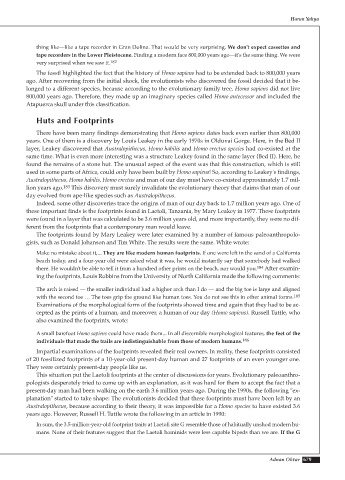Page 681 - Atlas of Creation Volume 2
P. 681
Harun Yahya
thing like—like a tape recorder in Gran Dolina. That would be very surprising. We don't expect cassettes and
tape recorders in the Lower Pleistocene. Finding a modern face 800,000 years ago—it's the same thing. We were
very surprised when we saw it. 182
The fossil highlighted the fact that the history of Homo sapiens had to be extended back to 800,000 years
ago. After recovering from the initial shock, the evolutionists who discovered the fossil decided that it be-
longed to a different species, because according to the evolutionary family tree, Homo sapiens did not live
800,000 years ago. Therefore, they made up an imaginary species called Homo antecessor and included the
Atapuerca skull under this classification.
Huts and Footprints
There have been many findings demonstrating that Homo sapiens dates back even earlier than 800,000
years. One of them is a discovery by Louis Leakey in the early 1970s in Olduvai Gorge. Here, in the Bed II
layer, Leakey discovered that Australopithecus, Homo habilis and Homo erectus species had co-existed at the
same time. What is even more interesting was a structure Leakey found in the same layer (Bed II). Here, he
found the remains of a stone hut. The unusual aspect of the event was that this construction, which is still
used in some parts of Africa, could only have been built by Homo sapiens! So, according to Leakey's findings,
Australopithecus, Homo habilis, Homo erectus and man of our day must have co-existed approximately 1.7 mil-
lion years ago. 183 This discovery must surely invalidate the evolutionary theory that claims that man of our
day evolved from ape-like species such as Australopithecus.
Indeed, some other discoveries trace the origins of man of our day back to 1.7 million years ago. One of
these important finds is the footprints found in Laetoli, Tanzania, by Mary Leakey in 1977. These footprints
were found in a layer that was calculated to be 3.6 million years old, and more importantly, they were no dif-
ferent from the footprints that a contemporary man would leave.
The footprints found by Mary Leakey were later examined by a number of famous paleoanthropolo-
gists, such as Donald Johanson and Tim White. The results were the same. White wrote:
Make no mistake about it,... They are like modern human footprints. If one were left in the sand of a California
beach today, and a four-year old were asked what it was, he would instantly say that somebody had walked
there. He wouldn't be able to tell it from a hundred other prints on the beach, nor would you. 184 After examin-
ing the footprints, Louis Robbins from the University of North California made the following comments:
The arch is raised — the smaller individual had a higher arch than I do — and the big toe is large and aligned
with the second toe … The toes grip the ground like human toes. You do not see this in other animal forms. 185
Examinations of the morphological form of the footprints showed time and again that they had to be ac-
cepted as the prints of a human, and moreover, a human of our day (Homo sapiens). Russell Tuttle, who
also examined the footprints, wrote:
A small barefoot Homo sapiens could have made them... In all discernible morphological features, the feet of the
individuals that made the trails are indistinguishable from those of modern humans. 186
Impartial examinations of the footprints revealed their real owners. In reality, these footprints consisted
of 20 fossilized footprints of a 10-year-old present-day human and 27 footprints of an even younger one.
They were certainly present-day people like us.
This situation put the Laetoli footprints at the center of discussions for years. Evolutionary paleoanthro-
pologists desperately tried to come up with an explanation, as it was hard for them to accept the fact that a
present-day man had been walking on the earth 3.6 million years ago. During the 1990s, the following "ex-
planation" started to take shape: The evolutionists decided that these footprints must have been left by an
Australopithecus, because according to their theory, it was impossible for a Homo species to have existed 3.6
years ago. However, Russell H. Tuttle wrote the following in an article in 1990:
In sum, the 3.5-million-year-old footprint traits at Laetoli site G resemble those of habitually unshod modern hu-
mans. None of their features suggest that the Laetoli hominids were less capable bipeds than we are. If the G
Adnan Oktar 679

